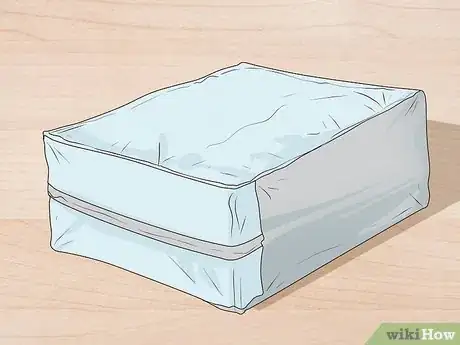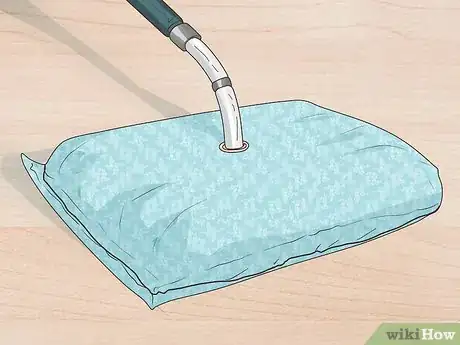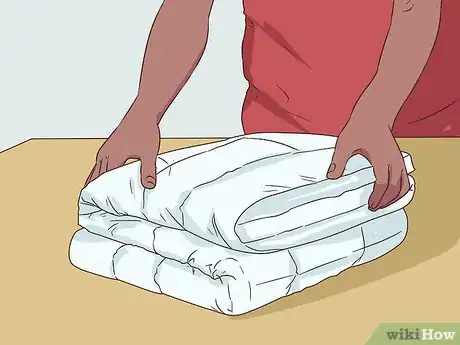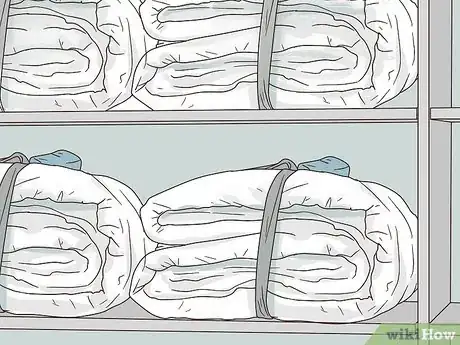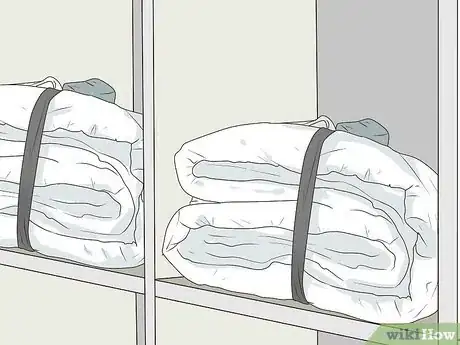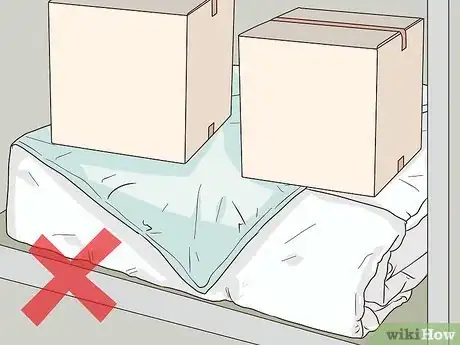This article was co-authored by Safir Ali. Safir Ali is the Co-Founder and CEO of Hamper Dry Cleaning and Laundry, a startup in Houston, Texas reinventing the laundry industry. With over six years of experience launching and operating Hamper, Safir specializes in innovative ways to simplify dry cleaning using the experience from his family's business. Safir holds a Bachelor’s degree in Business Administration and Management from Texas A&M University. Hamper offers 24/7 on-demand dry cleaning and laundry through delivery and kiosk services. Hamper has been featured on the Houston Rockets, Station Houston, the Houston Business Journal, BBVA, Yahoo Finance, and Innovation Map.
This article has been viewed 33,608 times.
When storing your comforter, conserving space while preventing mold, mildew, and bug infestations is a top priority. Whether you own a down comforter or a synthetic comforter, there are strategies you can follow to ensure proper storage. By doing things such as making sure your comforter is clean and choosing the right storage container, your comforter will get the storage care it needs.
Steps
Washing Your Comforter
-
1Wash your comforter with mild detergent. If you don't wash your comforter before storing it, dead skin cells, foods, oils, and stains left on the comforter will attract bugs and cause it to deteriorate faster. Wash your comforter in a front-loading washing machine with mild detergent.[1]
- A down comforter should be washed on a delicate cycle or hand washed.
- Having your down comforter dry-cleaned is also an option.
-
2Dry your comforter on low heat in a large-capacity dryer. Put your down comforter in the dryer and set the heat to low. It might take several hours for the comforter to completely dry due to its size and weight. Place a dryer ball or dryer ring in with your comforter to help prevent it from clumping while drying.[2]
- If you have a synthetic comforter, you can let it air dry as an alternative to using a dryer. Down comforters should not air dry.
- Always try to use a large-capacity dryer — comforters become even heavier once they're soaking wet, and you don’t want your dryer to break due to the weight and strain.
Advertisement -
3Feel your comforter to make sure it's completely dry. Making sure the comforter is completely dry before storing it will help prevent mold and mildew from forming. Once your comforter comes out of the dryer, touch it to see if it's still damp. If it is still wet, you can either throw it back in the dryer to run another cycle, or you can lay it out overnight.[3]
Fitting Your Comforter into a Bag
-
1Store down comforters in breathable cotton. A breathable cotton bag will reduce the risk of mold and mildew affecting your down comforter. Do not store your down comforter in plastic, as this can damage the comforter and increase the risk of mold and mildew.[4]
-
2Try vacuum sealing synthetic comforters. Vacuum sealing will reduce the comforter's surface area while also keeping it well protected.[5]
- If your comforter is older or made of a delicate material, be wary of vacuum sealing.
- If you don't have vacuum-sealable bags, you can store your synthetic comforter in breathable cotton or regular plastic as well.
-
3Fold your comforter so that it will fit in the sealed bag. Comforters are large and bulky, so you’ll need to fold yours several times to help reduce its volume. Fit the comforter in your breathable bag of choice and close it up.[6]
- Most of these bags will have a drawstring or zipper to close it.
- While the bag doesn't need to close all the way, sealing it up will prevent dirt and bugs from being able to reach it.
Finding a Storage Spot
-
1Look for a cool, dry location. Mold and mildew love warm, damp environments, so store your comforter in a spot that will stay cool and dry. Try to pick a spot that's off of the ground and indoors. Stay away from sheds or other outdoor storage locations — bugs have an easier time accessing these spots.[7]
-
2Choose a linen closet or similar spot, if possible. A linen closet is the best option for storing your comforter — it keeps it off the ground and in a clean closet. If you don't have a linen closet, you can also store your comforter on an extra shelf or in a clean cabinet.[8]
- If you have a piece of furniture that acts as a storage container, such as an ottoman, you can store your comforter there.
- Storing your comforter in a plastic bin is fine as long as it's sealed in a protective bag as well.
-
3Don't store anything on top of your down comforter. To prevent the feathers in your down comforter from being damaged, don't put anything on top of the sealed bag. If the comforter will be going in a closet stacked with several other things, place the down comforter on the very top.
Expert Q&A
-
QuestionHow often should you wash a comforter?
 James SearsJames Sears leads the customer happiness team at Neatly, a group of cleaning gurus based in Los Angeles and Orange County, California. James and the team have nine years of experience and offer green cleaning, interior and exterior window washing, and general apartment cleaning services. He provides transformative cleaning experiences by reducing clutter and renewing your home environment. James is a Trustee Scholar at the University of Southern California.
James SearsJames Sears leads the customer happiness team at Neatly, a group of cleaning gurus based in Los Angeles and Orange County, California. James and the team have nine years of experience and offer green cleaning, interior and exterior window washing, and general apartment cleaning services. He provides transformative cleaning experiences by reducing clutter and renewing your home environment. James is a Trustee Scholar at the University of Southern California.
House Cleaning Professional Many comforter manufacturers only recommend washing a comforter once every 3–5 years. Follow the instructions on the tag.
Many comforter manufacturers only recommend washing a comforter once every 3–5 years. Follow the instructions on the tag.
References
- ↑ http://www.countryliving.com/home-design/decorating-ideas/advice/a5521/how-to-take-care-of-your-bedding/
- ↑ http://www.goodhousekeeping.com/home-products/comforter-reviews/a18163/comforter-guide-care/
- ↑ http://www.countryliving.com/home-design/decorating-ideas/advice/a5521/how-to-take-care-of-your-bedding/
- ↑ https://www.familyhandyman.com/storage-organization/how-to-store-seasonal-bedding/view-all/
- ↑ https://www.familyhandyman.com/storage-organization/how-to-store-seasonal-bedding/view-all/
- ↑ http://www.countryliving.com/home-design/decorating-ideas/advice/a5521/how-to-take-care-of-your-bedding/
- ↑ https://www.familyhandyman.com/storage-organization/how-to-store-seasonal-bedding/view-all/
- ↑ https://www.familyhandyman.com/storage-organization/how-to-store-seasonal-bedding/view-all/
- ↑ https://www.familyhandyman.com/storage-organization/how-to-store-seasonal-bedding/view-all/



